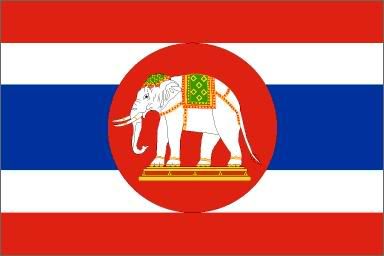PUN TUAO KONG SHRINE (KATHU)
This morning, Tim and I ventured out to make merit at Pun Tuao Kong — a Chinese shrine high on Patong Hill between Kathu and Patong. It's location at a bend of Prambaramee Road (Highway 4029) causes it to be seen by any motorist who ventures east out of Patong; many don't stop but the Thais (and some expats) will give a few short beeps of their horn as they pass by. Not only was it my first time praying at this small temple, it was Tim's first visit as well.
We began the morning by stopping at the Kathu market so we could purchase items to give as alms. Our offerings included two whole chickens, bunches of longan and rambutan, as well as about a dozen strands of puang malai (flower garlands).
Each temple or shrine seems to have a slightly different routine to the order in which you do things. At Pun Tuao Kong, we first presented our bags of meat and fruit. The flower garlands were separated from this offering and we proceeded to several small shrines where we draped the fragrant stands over various Buddha images. We were then given bundles of joss sticks, several candles, and a roll of Chinese "lucky money". We lit the candles and placed them in holders at the rear of the main shrine.
The joss sticks were then lit and we went from one small shrine to another where we prayed and then stuck the sticks into the sand; I was lucky in that I didn't burn myself this time (not easy to do as you need to place the sticks firmly among many other white-hot sticks). There's actually a specific order in which you need to visit the sub-shrines; I'm sure it was amusing to view as I tried to follow Tim's lead while she wasn't entirely certain of the order. You also are supposed to place only three joss sticks at each shrine (somehow, I finished before I ran out of shrines). Several of these shrines have space where you need to kneel and pray (using the wai) while several have barely enough room to stand. All of this takes place amidst a haze of smoke and your eyes really do begin to water after a short while.
I forget the exact order of things but at one point, we stood in front of a large furnace-like altar where we placed the Chinese "lucky money" (one at a time) atop the flames. Again, I succeeded in not getting burnt (a good sign). We also had to take platefuls of the food we brought as offerings and set them on various parts of the main shrine (the plate with the two chickens was particularly heavy).
One of the last steps of the ceremony (or perhaps it was just a select few as Tim didn't do this) was to pick up a can of what looked like shaved bamboo chopsticks (I can't remember the name of these). You kneel in front of the altar and shake the can rhythmically back and forth until one of the sticks works its way to the top and falls to the floor. The shrine's attendant then read the number on the stick, approached a nearby wooden cabinet where he opened a drawer with the corresponding number, and handed me a slip of paper. This paper apparently gives my fortune but Tim couldn't translate it for me ("it mean you have everything, everything," she told me); I'll see about getting it properly translated sometime.
I was then given a pair of red wooden blocks made from bamboo roots in the shape of a mango (actually, it looked more like two halves of a banana to me). I was supposed to toss these up and have them land on the ground. I had no idea what this was for but a bit of research at home has revealed that these are supposed to help me make decisions. One poses a question requiring a "yes" or "no" answer and then watch how they land when they hit the floor. If both land with the same side up, the answer is "no"; if they land one side up and the other down, then the answer is "yes."
In addition to the alms, we also gave a small donation for the upkeep of the shrine.
It was a very interesting experience. We were even joined halfway through by our friends Lek and Jum.

ไม่มีความคิดเห็น:
แสดงความคิดเห็น